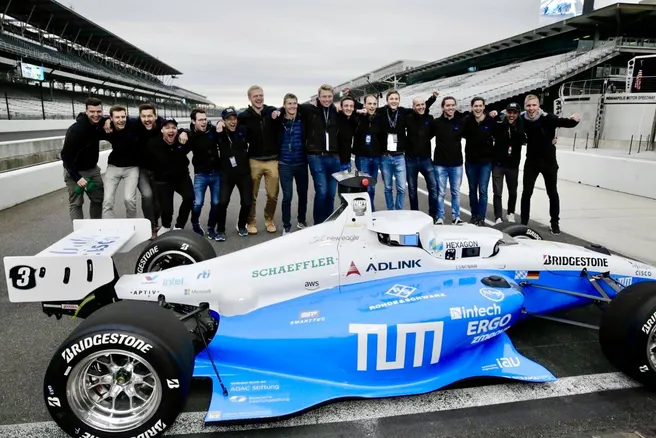The Indy Autonomous Challenge was held at the Indianapolis Motor Speedway on Saturday – a race completely without drivers. Nine teams from universities around the world competed against one another with race cars controlled using Artificial Intelligence (AI). The Technical University of Munich (TUM) team made the best time with an average speed of 218 kilometers per hour. That won the young researchers first place and a cash prize of one million US dollars.
The Saturday race at the Indianapolis Motor Speedway was very unique: The race cars weren't piloted by humans, but by computers. Universities from around the world were called on to develop systems based on Artificial Intelligence that would make it possible for the cars to drive the track autonomously. The competition was organized by the non-profit Energy Systems Network and the Indianapolis Motor Speedway. The main objective of the race was to promote the technological development of autonomous driving and advanced driver assistance systems.
Qualifying for the race is a success in and of itself: Only nine teams were allowed to participate in the race. Represented by its "TUM Autonomous Motorsport" team, TUM was the only German university among the nine. The young TUM researchers' car managed an average speed of 218 kilometers per hour. "We're totally thrilled by the results," says team manager Alexander Wischnewski. "Our objective was to break 200 km/h, and we did exactly that." Second place went to the "EuroRacing" team, a joint effort on the part of the University of Modena and Reggio Emilia, University of Pisa, ETH Zurich and the Polish Academy of Sciences.
Extremely fast reactions necessary
"The Indy Autonomous Challenge places tremendous demands on a vehicle," says Wischnewski. "In contrast to normal street traffic there are practically no rules, which means the behavior of the other vehicles is very hard to predict. At speeds of up to 300 kilometers per hour the software has to react to changes extremely quickly."
In just a fraction of a second the on-board computer captures and analyzes all the information supplied by the car's cameras, LIDAR sensors, GPS receivers and radar sensors. It then uses the data to make predictions about where the other vehicles are moving so that decisions can be made and passed on to the steering and braking systems as driving commands.
Highly realistic simulations
Approximately 60 doctoral candidates and students from the TUM Chair of Automotive Technology and Chair of Automatic Control worked for a year and a half on a software architecture which could safely and quickly master these assignments. In the process they applied experience gained in previous projects: As part of the Roborace demonstrations, the 2018 TUM Autonomous Motorsport Team participated in the Formula-E event in Berlin and in the 2019 event on the race track in Monteblanco, Spain. Nevertheless, they had to develop a completely new software basis to accommodate the different conditions and rules of the current race.
"We put a lot of time and energy into simulating the race car and the race course," says Wischnewski. One major challenge was the task of digitally simulating the optical cameras and lasers. The researchers and students also succeeded in simulating races with as many as eight autonomous race cars. "The virtual races made it possible for us to recognize and correct a lot of errors in advance. This also gave us an advantage, since transferring the software to the real car was not a big issue."
Solutions suited to street traffic
The victory in the Indianapolis race is a great success for the team. But the researchers wanted more, Wischnewski says. "The race lets us test and optimize an autonomous vehicle's rapid reactions to unpredictable events taking place at high speeds. This brings us a big step ahead in the development of autonomous vehicles which are safe in street traffic."
Wischnewski points out another important aspect: "We were also able to learn a lot about how the individual software components interact with one another. Research projects often concentrate on just a few specific questions. Here we have a chance to see what difficulties emerge when we look at the complete system."
TUM President Thomas F. Hofmann saluted the victory: "What a fantastic success for our TUM team – My sincere congratulations! This victory once again proves that Germany will still be able to hold the lead in the future by combining curiosity, team spirit and engineering sciences. Four victories in the Hyperloop competition, the recent fantastic success of the TUM Boring project, and now the Indy Autonomous Challenge: Teams from TUM won in each one of these highly distinguished, global competitions. We can all be proud of that!"
